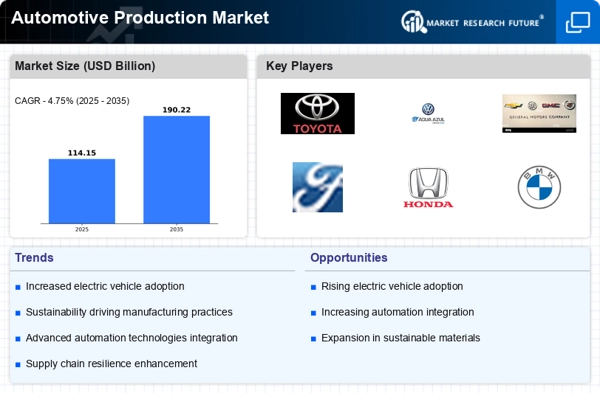The Automotive Production Market is currently characterized by a dynamic competitive landscape, driven by technological advancements, sustainability initiatives, and evolving consumer preferences. Major players such as Toyota Motor Corporation (Japan), Volkswagen AG (Germany), and General Motors Company (United States) are at the forefront, each adopting distinct strategies to enhance their market positioning. Toyota (Japan) continues to emphasize hybrid and hydrogen fuel cell technologies, aiming to lead in eco-friendly vehicle production. Meanwhile, Volkswagen AG (Germany) is heavily investing in electric vehicle (EV) infrastructure, reflecting a commitment to electrification and digital transformation. General Motors Company (United States) is focusing on software integration and autonomous driving technologies, indicating a shift towards a more tech-centric automotive future. Collectively, these strategies not only shape their individual trajectories but also influence the broader competitive environment, fostering a climate of innovation and sustainability.
In terms of business tactics, companies are increasingly localizing manufacturing to mitigate supply chain disruptions and enhance responsiveness to regional markets. This approach is particularly evident in the context of a moderately fragmented market structure, where the collective influence of key players is significant. The emphasis on supply chain optimization is paramount, as firms seek to streamline operations and reduce costs while maintaining quality. This competitive structure allows for both collaboration and rivalry, as companies navigate the complexities of global production networks.
In August 2025, Toyota Motor Corporation (Japan) announced a partnership with a leading battery manufacturer to develop next-generation solid-state batteries. This strategic move is poised to enhance Toyota's EV offerings, potentially positioning the company as a leader in battery technology. The collaboration underscores the importance of innovation in the automotive sector, particularly as consumers increasingly demand longer-range and faster-charging electric vehicles.
In September 2025, Volkswagen AG (Germany) unveiled its ambitious plan to establish a new EV manufacturing facility in North America. This initiative not only signifies Volkswagen's commitment to expanding its footprint in the lucrative North American market but also reflects a broader trend of regional manufacturing localization. By investing in local production capabilities, Volkswagen aims to reduce logistics costs and improve supply chain efficiency, thereby enhancing its competitive edge in the EV segment.
In October 2025, General Motors Company (United States) launched a new software platform designed to integrate advanced driver-assistance systems (ADAS) across its vehicle lineup. This platform is expected to enhance the user experience and safety features, aligning with the growing consumer demand for connected and autonomous vehicles. The introduction of this technology illustrates GM's strategic focus on software development as a critical component of its future growth strategy.
As of October 2025, the automotive industry is witnessing a pronounced shift towards digitalization, sustainability, and artificial intelligence integration. These trends are reshaping competitive dynamics, with strategic alliances becoming increasingly vital for innovation and market penetration. The emphasis on collaboration over price-based competition suggests that companies will need to differentiate themselves through technological advancements and reliable supply chains. Looking ahead, the competitive landscape is likely to evolve further, with a focus on innovation and sustainability becoming paramount in defining market leadership.

















Leave a Comment